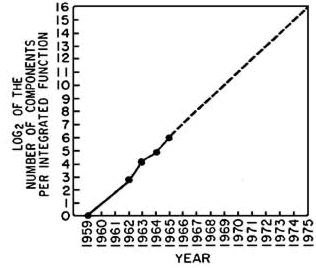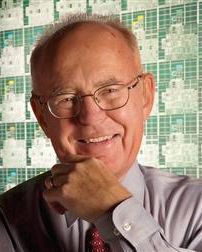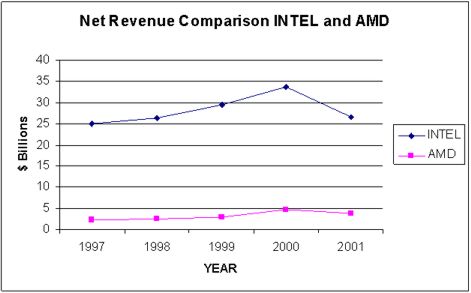The author intends to research into Intel Corporation and Advanced Micro Devices (AMD). Comparisons and contrasting of research shall be made to determine the prospects of employment for graduates. Intel and AMD are world leaders in the manufacturing of microprocessors.
Brief History – Invention of the Microprocessor
Intel had a head start over AMD form day one. In 1971 a young scientist at Intel, Ted Hoff had an idea to produce something better than what was in existence at the time. Hoff designed the 4004 chip, which only measured a mere 1/8” by 1/16” with 2300 transistor etched on the silicon. The 4004 was revolutionary at the time as it miniaturised computer technology. The 4004 matched the power of the ENIAC (gigantic at 30 tons!) a computer build in 1946 which could do 5000 calculation in one second. Although by today’s standards this is minuscule it was still 10 time faster than any mechanical alternative.
Moore ’s Law
Another interesting fact to note is that in 1965 Gordon Moore, head of Research and Design department of Intel made a very famous observation. He discovered that the number of components (e.g., transistors) doubled every year.

Gordon Moore —philanthropist, engineer and chairman emeritus of Intel

Figure 1 Moore‘s Original Law: Logarithm of the Number of Components on a Memory Chip Over Time.
Intel Corporation Founded
Robert Noyce and Gordon Moore founded Intel in July of 1968. They had each put $250,000 each and got a further $2.5 million in investments.
Advanced Micro Devices Founded
AMD was founded by Jerry Sanders and seven others on May 1 st 1969. AMD provides Windows compatible processors alongside other devices such as memory devices and networking products.
Organisational Environment
From when Compaq invented the IBM PC clone it was important to be IBM compatible. Eventually IBM lost first place and Intel took the lead. Suddenly it was important to be Intel, Pentium compatible. Microsoft grabbed the standard and declared the AMD’s chips to be “Windows-Compatible”. Inevitability Intel did not like this.
Fortunately for Intel AMD (Cyrix IDT chip cloners) all aim for the low-end of the market.
Contrasting Both Brands
It is widely accepted that Intel processors perform better with applications such as Microsoft Office XP, Word, Excel, PowerPoint etc. AMD however performs better than Intel in games such as Quake III.
Corporate users, SME’s, Schools, and universities choose the Intel processor for it’s superiority on applications. Gamers and people on low budgets opt for the AMD range of processors simply because they cost less.
High End INTEL Processor (Year 2000)The following are Intel’s top 5 processors at the time of the production of this report:
High End AMD Processors (Year 2000) The following are AMD’s top 5 processors at the time of the production of this report:
|
Figure 2 Comparisons of High End Processors
As you can see form Figure 2 Intel dominate on the high end side of the market over AMD. Intel processors incorporate Level 2 cache memories of 512KB double that of AMD. Level 2 cache is very important to a processors ability to perform well. It is the memory with in the processor that is uses to complete calculations. So logically the more L2 Cache memory you have the faster the processor shall run.
INTEL Low End of the Spectrum
Intel slashes the Giga hertz and reduces the level to cache to 256KB on the Celeron range of processors. These processors are aimed at buyers with low budgets.
AMD Low End of the Spectrum
AMD’s low-end processor Duron has a performance advantage over Intel and its own low end processor Celeron.
Intel however still has the support of the majority of PC original equipment manufacturers (OEMs)-a crucial factor to its market dominance.
Revenues
| CHIPMAKER |
1997 |
1998 |
1999 |
2000 |
2001 |
| INTEL |
25.1 |
26.3 |
29.4 |
33.7 |
26.5 |
| AMD |
2.3 |
2.5 |
2.8 |
4.6 |
3.8 |
Table 1 Revenue Comparison
Figure 3 Net Revenue Comparison INTEL and AMD
Market Share
Intel clearly has market dominance with 83% of the market. Yet AMD with its mere 15% market share continues to compete with successfully.
AMD’s Athlon line of processors have been successfully competing with Intel’s Pentium 4 processors. AMD has also proved
| CHIPMAKER | MARKET SHARE |
| INTEL | 83% |
| AMD | 15% |
| OTHER CHIPMAKERS (CYRIX, IDT etc.) | 2% |
Table 2 Market Share
Number of Employees
| CHIPMAKER | Number of Employees |
| INTEL | 100,000 |
| AMD | 14,757 |
Table 3 Number of Employees
Future Forecast
Based on Moore’s theory Figure 2 Page 4 in the next five years we shall see Intel manufacturing an 8.3Ghz processor and AMD a 7.2Ghz processor based on current processor speeds. It is inevitable that job cuts would be made with both parties especially Intel shall be forced to reduce their profits by reducing their personnel in order to be at a competitive with AMD.
Figure 3 show a decline in revenue for Intel and AMD. During the next five years this shall continue to be the case. Intel and AMD will reach the point where they will be no longer generating substantial profits.
It is evident from all the research analysed that Moore’s theory is being pushed to the physical and economical limit. There are only so many transistors you can etch on a piece of silicon! It is the author’s hypothesis that a new kind of processor material or architecture shall be designed to increase the performance of processors at a lower cost per unit.
Conclusions
Intel is clearly the market leader in the manufacture of microprocessors based on their revenue forecasts and market share dominance. Intel has 6 times the number of employees the AMD. Figure 2 Comparisons of High End Processorsproves that Intel is better processors like for like with AMD.
The author’s hypothesis has been proved to be true. AMD ranks in at number 2 with approximately a tenth of Intel’s revenue with only 15% of the market share.



